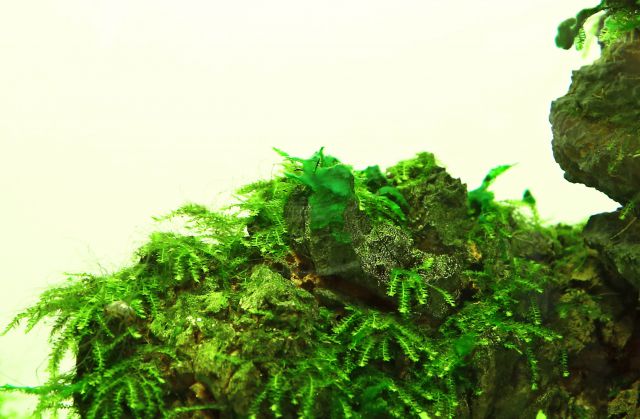In order to get answers to basic questions all around algae in the aquarium, we recommend you read this article first.
Biologically speaking, blue-green algae are no algae but bacteria. In contrast to all algae, these cyanobacteria (also called blue bacteria) do not have a true nucleus, however, just like plants, they can photosynthesize. There are many different types of BGA, some float in the water (e.g. some species in the genus Microcystis) or some that form gelatinous lumps on wet ground (Nostoc). However, in the aquarium hobby we know cyanobacteria as dark green, blue-green to almost black coats on aquatic plants, decoration or the substrate. They feel slimy to the touch and are thus sometimes called slime algae. Their unique pungent smell is characteristic - the odor can be described as "foul" or "earthen". Quite often, slime algae belong to the genus Oscillatoria (filamentous cyanobacteria). Small populations, for example on the fringe between the substrate and the front glass, are quite normal and no reason to fret.
Common causes
As with true algae, a nutrient imbalance may be the reason for an outbreak of cyanobacteria in a planted aquarium. In various cases, the reason was a highly elevated phosphate level, sometimes in combination with a nitrogen deficiency (more specifically, a nitrate deficiency).
On the one hand, a regular water change is thus highly important to prevent this kind of nutrient spikes. We recommend to exchange around 50% of the aquarium volume per week. On the other hand, in a planted tank a balanced nutrient supply is crucial for the healthy development of the plants. Quite frequently, carbon (CO2) and macronutrient (NPK) deficiencies are the reason for the formation of algae. In the following list you can find the target values for the individual nutritional elements:
- A CO2 content of approximately 20-30 mg/l, measurable by a permanent test with test agent
- 10 to 25 mg/l of nitrate (NO3)
- 5 to 10 mg/l of potassium (K)
- 0.1 to 1 mg/l of phosphate (PO4)
- >10 mg/l of magnesium (Mg)

Moss cushions infested with cyanobacteria.
Blue-green algae are bacteria, and one of the reasons for a BGA infestation may lie in a disturbance in the balance of the so-called microflora. This term applies to all the bacteria and microorganisms in the biofilms of the aquarium. If these other microorganisms are present in insufficient numbers or if there is an imbalance of them and cyanobacteria, BGA may increase their numbers significantly as they lack competitors for nutrients. This phenomenon occurs most frequently during the cycling phase of a tank, as the biological system is still finding its balance. In this case you ought to add beneficial bacteria to your tank, for example by using preparations containing these bacteria, like Special Blend and Nite-Out II. It may also be helpful to add some muck or filter sludge from another aquarium that is biologically stable.
Control
Individual small BGA populations can easily be siphoned off with a hose, as they do not attach firmly to the substrate. If you notice that the blue-green algae recur always in the same places, you can easily fight them by fogging them with hydrogen peroxide.
In the case of a stronger BGA infestation we recommend the so-called black-out treatment.
Another measure against blue-green algae that works quite well in planted tanks is the so-called potassium treatment. Here you add a single-ingredient potassium fertiliser until the concentration of the nutrient potassium (K+) is around 30 mg/l. Maintain this level for about a week. In order to adapt the nutrient situation to the new conditions, the nitrate content should be adjusted to around 20 mg/l. After the week has elapsed, perform a maximum water change and reduce the fertiliser dosage to a normal level. Very probably, this targeted nutrient spike and the spurt in plant growth that results from it will cause the blue-green algae to disappear.
As a first-aid treatment we'd also like to mention some algicides that are aimed directly against blue-green algae. For instance, you could use Blue Exit manufactured by Easy Life. Alternatively, we recommend a full treatment of your aquarium with hydrogen peroxide. You can find exact instructions here.